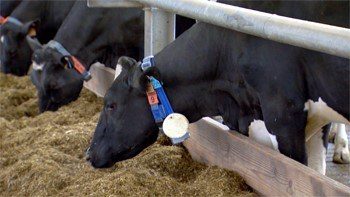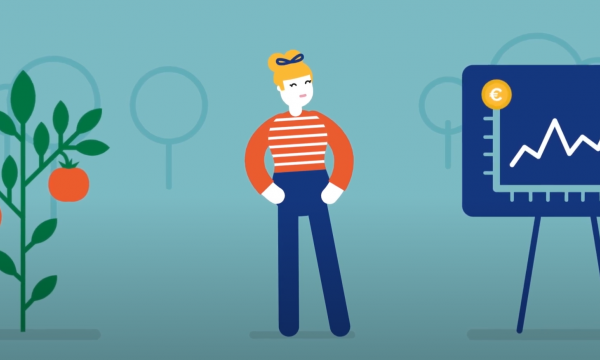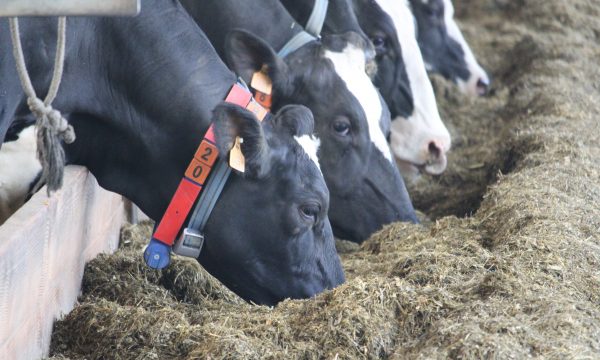Press release | Video MoniCow takes an important step towards more efficient cattle monitoring

After three years of research, the partners of the imec.icon project MoniCow have a prototype ready that offers a solution for cattle monitoring. For first time, different indicators for fertility and health are integrated in a minimal number of sensors (ear tag + collar) which continually send real-time data. The risk of missing an estrus (heat) or time of calving ²is therefore reduced. According to the researchers, the farmer could save up to 200 euro savings per cow per year, taking veterinary costs, suboptimal yield, and intense labor into account.
Another interesting aspect is the real-time localization (up to 30 cm) of the cows in the stable and the inductive charging system of the sensors, which solves the battery-charging problem. The partners - ILVO, imec-UGhent, KU Leuven, Delaval, NXP Semiconductors Belgium, Multicap, Metagam and SnapTonic – have joined to meet one of the farmers’ requests: smarter, more integrated, more user-friendly and energy-efficient equipment.
Increased need for monitoring
The end of the European milk quotas, an increasing global demand for milk, and intense competition on the world market has led to a trend of upscaling of dairy farming. Economies of scale lead to technical and economic optimization as well as new challenges. As the number of animals in the herd increases, the farmer cannot always visually monitor the health and fertility cycle of the individual animals. For this reason, much attention has been paid in the recent years to the development of technological tools to help monitor the livestock. An extra pair of high-tech eyes and ears in the form of sensors to monitor the animals, both inside and outside the barn, are not an unnecessary luxury in the current practice of Flemish dairy farming.
No need for a high number of sensors: MoniCow offers a total solution
Many monitoring systems can be found on the market, but they are all limited in functionality. For example, they only measure one parameter or transmit data via a low frequency. In addition, they all use batteries with a limited lifespan. When these batteries are empty, the dairy farmer misses some data while the batteries are being replaced. This loses the very added value of monitoring: a continual flow of data.
In the MoniCow project, experts in the Internet of Things (IoT) and animal sciences have joined forces with experts from the dairy farming sector and the semiconductor industry to eliminate the existing technological bottlenecks and move towards more efficient monitoring. The result is an integrated total solution: a system that monitors various parameters of health and fertility with a limited number of sensors (does not hinder the cows) and which sends real-time updates.
Time of calving, heat detection and early detection of disease symptoms
Specifically, MoniCow consists of a temperature sensor in the ear tag of the cow and a localization and movement sensor in the collar. These generate a continuous flow of data processed by software specifically developed for that function. Smart algorithms translate the raw data into bite-sized information and advice for the dairy farmer. For example, the time of calving can be predicted up to 24 hours in advance, when the sensors detect that the cow eats and ruminates less and becomes more calm. The same applies to heat detection, when the system detects that the cow takes more steps, absorbs less feed and falls below normal. Finally, these sensors also have the potential for early detection of illness or other health problems.
Extra feature: where is my cow?
In addition to a number of health and fertility indicators such as rumination and locomotion, the MoniCow system constantly monitors the location of the cows in the stable. Accurate and fast determination of the cow’s location is crucial when she needs care quickly, but it also provides useful information about each cow’s behavior. For example: how often does a cow visit the feeder, what distance is covered in the stable, and how often does she rest? Existing localization systems are not accurate enough for this, but the MoniCow system is: thanks to the integration of an ultra-broadband localization unit, it registers the cow's position in the stable with an accuracy up to 30 cm.
Inductive wireless charging guarantees continuous real-time data
The more parameters a system monitors and the more often it is updated, the more energy it uses. Because standard batteries are not suitable for this, the MoniCow sensor has an innovative inductive charging system - comparable to a wireless charging system for smartphones - that is robust, can be charged quickly and can be installed on a feeder in the barn. Every time the cow eats concentrates, the batteries in the collar are automatically charged. This yields 100 J per visit, which is sufficient to keep the system active during the productive life of a cow. If installed on the milking robot, the battery could charge up to 1.3 to 2.5 kJ per day with this system.
Fast return on investment
On the basis of a literature study and discussions with an active dairy farmer and the various partners in the project, a conservative estimate was made to determine the cost and the return of the MoniCow sensor system. For a dairy barn such as the one at ILVO (where the prototype was tested) the investment required was estimated at € 20,000. That includes all hardware and software needed for 77 cows, the Flemish average. According to Frederic Vannieuwenborg, researcher at IDLab (an imec research group at Ghent University), this investment would pay off in short term because it generates labor savings and reduces veterinary costs, among others. "According to the model that we used, the MoniCow system - on the condition that it is completely up-to-date - can save the dairy farmer about 200 euros per cow per year. In that case, the investment will be recouped in just over a year." These results are so promising that the partners would like to further develop the project. Additional pilot tests with more cows and on other farms are needed to validate the system and refine the algorithms. Potential investors are encouraged to contact imec-UGent and ILVO.


